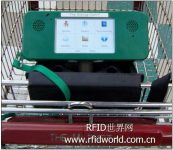
Mobile RFID shopping devices help stores increase sales
[ad_1]
Shoppers at a supermarket in Park City, Utah, are now carrying an RFID device to track their location in the store and display coupons, receipts, and promotional videos based on the location. This system-Giving Cart-was developed by Time Domain and Klever Marketing and was first used by the independent department store The Market.

The store manager Mike Holm hopes that the system can increase customer loyalty and provide information about shoppers’ behavior, including where they spend more time and how long they wait at the checkout counter.
“The challenge we face is how to better communicate with customers and increase sales,” Holm said. In order to achieve this goal, he met with Klever Marketing at the beginning of this year and jointly designed the Giving Cart system.
The system includes Time Domain’s Precision Location Ultra Wideband System (PLUS) tracking system, which uses RFID chips, readers, antennas and Wi-Fi access points, and Klever Marketing software for promotional materials and coupons. Klever also designs the Giving Cart mobile device, which embeds Time Domain’s RFID chip.
Since Labor Day this year, the receptionist at the entrance of The Market began to recommend the use of mobile devices to shoppers, explaining its advantages and usage. Shoppers who agree to try the device can hold the device or place it in the shopping cart. When the device is idle, it is plugged into a kiosk for charging.
The store, with an area of approximately 40,000 square feet, has a total of 44 RFID readers and antennas installed on the ceiling, and initially adopted 50 mobile devices, according to Greg Clawson, Senior Director of Global Sales and Marketing at Time Domain.
Each device sends a 6.6 GHz signal with its ID code, and at least three readers capture the signal simultaneously to locate the device. The reader then sends the ID code of the tag device via the Ethernet connection to a server running Time Domain software, which determines that the tag’s position accuracy is within 1 foot. Based on this information, the Klever software then uses the Wi-Fi connection to notify the mobile device of its location. The software of the mobile device displays coupons or promotional information for products in this area (for example, when a shopper approaches a certain area, it displays discount information for a certain brand of peanut butter). The shopper then presses a button on the touch screen of the mobile device to select the coupon she wishes to redeem.
In order to increase the attractiveness of this system, the store also designed a “Music Award” event. The system will arbitrarily select some mobile devices in use to make them emit music, which means that customers who use these devices can get rewards, such as a cash discount on the total shopping price. When the customer checks out, she shows the device to display the coupon or reward. When the shopper completes the checkout, the device is taken back by the receptionist or other employees and placed in the kiosk to recharge.
In the future, Clawson said, when users place products in the shopping cart, they can scan the printed barcodes on each product package to generate the overall price and speed up the cash register.
Store mobile devices can also display promotional information of other local businesses, such as nearby restaurants.
Holm is very satisfied with this system, saying that after the installation of this system, sales have increased, especially for discounted products. Neither Holm nor Giving Cart developers disclosed the cost of The Market to install and operate the system.
Giving Cart is different from other RFID shopping cart solutions. Because it is a handheld solution, Clawson said that stores do not need to install RFID devices on all shopping carts, because the carts are rarely used in full, which can save costs.
[ad_2]





